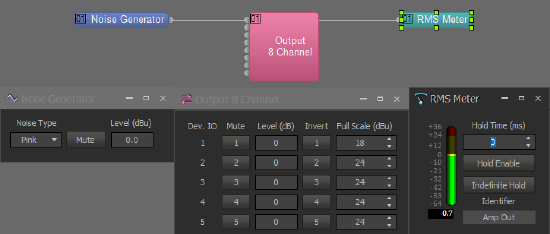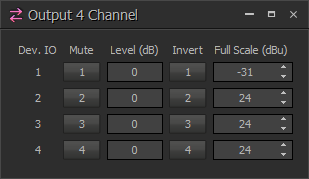Setting amplifier gain for optimal sound levels
This article explains how to set amplifier gain to achieve optimal loudspeaker levels in a sound system. In many cases, available amplifier power exceeds the power required to produce the desired sound pressure level (SPL) at the listener location. Even if the system is capable of producing very loud levels without exceeding the ratings of its components, it is often preferred to limit the end user's available range as to not exceed reasonable sound levels for the application.
Before you begin
This article assumes that the gain settings of devices earlier in the signal path have been verified for best performance, and that the voltage arriving at the amplifier does not exceed its maximum peak or RMS voltage ratings, as described in the Gain structure and Input and output levels articles.
It is also assumed that the system design and installation has been vetted to confirm that the amplifier is sufficient for the number and type of loudspeakers and that they are wired and tapped correctly. When in doubt, consult with the system designer or refer to additional resources on Amplifier power calculations and Wiring inputs and outputs.
Target SPL
The first question that must be answered is what the target volume (in dBSPL) of the system should be. This depends on the purpose of the system. Conversational speech is typically measured at a nominal level of 60-65dBSPL. It is common practice to set the nominal or unity level in a conferencing system to 75dBA, such that a unity signal (0dBu in Tesira) produces an SPL of 75dBA at the listener location(s) after it has passed through the amplifier and loudspeakers. This allows the system to be a maximum of 10-15dB louder than normal speech, which allows for adjustment between different talkers and conference sources. This also leaves 24dB of headroom for peaks and ensures (with the proper use of limiters) that the peak level in the room does not exceed 99dBA.
A system used primarily for music, movies, or other program content can be more varied, but common practice is to match unity to 85dBA. In a system with both speech reinforcement and program audio, the 75dBA unity point is often still sufficient, because program audio is more predictable than speech and may require less headroom. For example, microphones may be set to a nominal level of 0dBu in Tesira, but program audio may safely run around 12-20 dBu, because there are less likely to be peaks that reach 24dBu. In any case, it is good practice to use limiters to prevent clipping at the amplifier input.
Sound level meters
For best results, it is recommended to use an ANSI Type 1 or 2 sound level meter with a calibrated measurement microphone, particularly if there is a requirement for compliance with OSHA, noise ordinances, or other jurisdictional regulations. Alternatively, there are many apps and microphones available for phones and tablets that offer similar measurements, typically at the expense of certain features and guaranteed accuracy.
Setting amplifier gain with pink noise
- Turn the amplifier attenuation pot(s) all the way down.
- Confirm that the DSP output voltage is matched to the amplifier's input sensitivity.
- Send pink noise at 0dBu to the DSP output(s). Ensure that no attenuation is applied in any DSP blocks - place an RMS meter at the output to confirm.
- Set the sound level meter to A frequency weighting, Slow time weighting. The nomenclature may vary by device, such as dBA Slow, LAS, etc.
- Slowly increase the level of the amplifier attenuation pot(s) until the desired SPL is reached. For best results, position the meter in multiple listener locations to confirm that the average is close to the desired SPL.
Setting amplifiers "wide open"
Typically the best signal-to-noise ratio (SNR) is achieved by supplying an amplifier with the highest possible voltage that does not exceed its maximum peak or RMS ratings and using its analog attenuation pot(s) as described above. However, on some amplifier models these knobs are located on the front for easy user access. This may be desirable in a mobile sound system, event space that is regularly reconfigured, or other scenarios where it is only within the reach of a trained engineer. However, in a school, house of worship, or other venue where these controls are accessible to the general public, it is sometimes preferred to set the amplifier attenuation "wide open," or all the way up, and attenuate the signal at the DSP output instead.
The process for this is similar:
- Turn down the DSP output(s) to the lowest level (in Tesira, -31dBu or mic level at the Full Scale (dBu) field in the output block).
- Turn up the amplifier attenuation pot(s) all the way.
- Send pink noise at 0dBu as described above.
- Incrementally increase the DSP output until the desired SPL is reached. The Full Scale (dBu) output in Tesira is adjusted in 6dB increments from 0-24dBu, so it may be necessary to attenuate the level at the Level (dB) field in the output block for finer increments.



